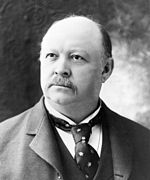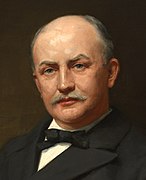| |||||||||||||||||||||||||||||||||||||||||||||||||||||||||||||||||||||||||||||||||||||||||||||||||||||||||
All 356 seats in the United States House of Representatives[c] 179 seats needed for a majority | |||||||||||||||||||||||||||||||||||||||||||||||||||||||||||||||||||||||||||||||||||||||||||||||||||||||||
|---|---|---|---|---|---|---|---|---|---|---|---|---|---|---|---|---|---|---|---|---|---|---|---|---|---|---|---|---|---|---|---|---|---|---|---|---|---|---|---|---|---|---|---|---|---|---|---|---|---|---|---|---|---|---|---|---|---|---|---|---|---|---|---|---|---|---|---|---|---|---|---|---|---|---|---|---|---|---|---|---|---|---|---|---|---|---|---|---|---|---|---|---|---|---|---|---|---|---|---|---|---|---|---|---|---|
| |||||||||||||||||||||||||||||||||||||||||||||||||||||||||||||||||||||||||||||||||||||||||||||||||||||||||
 Results: Democratic gain Republican gain Democratic hold Republican hold Populist gain Populist hold Silver hold | |||||||||||||||||||||||||||||||||||||||||||||||||||||||||||||||||||||||||||||||||||||||||||||||||||||||||
| |||||||||||||||||||||||||||||||||||||||||||||||||||||||||||||||||||||||||||||||||||||||||||||||||||||||||
The 1894 United States House of Representatives elections were held from June 4, 1894, to November 6, 1894, with special elections throughout the year. Elections were held to elect representatives from all 356 congressional districts across each of the 44 U.S. states at the time, as well as non-voting delegates from the inhabited U.S. territories. The winners of this election served in the 54th Congress, with seats apportioned among the states based on the 1890 United States census.
The elections comprised a significant political realignment, with a major Republican landslide that set the stage for the decisive election of 1896. The 1894 elections came in the middle of Democratic President Grover Cleveland's second term. The nation was in its deepest economic depression yet following the Panic of 1893, which pushed economic issues to the forefront. In the spring, a major coal strike damaged the economy of the Midwest and Mid-Atlantic. It was accompanied by violence; the miners lost and many joined the Populist Party. Immediately after the coal strike concluded, Eugene V. Debs led a nationwide railroad strike. It shut down the nation's transportation system west of Detroit for weeks, until President Cleveland's use of federal troops ended the strike. Debs went to prison for disobeying a court order. Illinois Governor John Peter Altgeld, a Democrat, broke bitterly with Cleveland.
The fragmented and disoriented Democratic Party was crushed everywhere outside of the South, losing more than 55% of its seats to the Republican Party. The Democrats did so poorly that even in the South, they lost seats to the Republican-Populist electoral fusion in Alabama, North Carolina, Tennessee, and Texas.[2][3] The Democrats ultimately lost 127 seats in this election, with the Republicans gaining 130 seats after the resolution of several contested elections.
The Democratic Party failed to win one seat in twenty-four states and only won one seat in six states. Prominent Democrats in the house including Richard P. Bland, William S. Holman, William M. Springer, and William L. Wilson were defeated in the election.[4] As of 2022, the 1894 election represents the largest seat swing in a single election in the history of the House of Representatives; the only other occasion where a political party has suffered triple-digit losses was in 1932.
The main issues revolved around the severe economic depression, which the Republicans blamed on the conservative Bourbon Democrats led by Cleveland. Cleveland supporters lost heavily, weakening their hold on the party and setting the stage for an 1896 takeover by the free silver wing of the party. The Populist Party ran candidates in the South and Midwest, but generally lost ground outside of the South. The Democrats tried to raise a religious issue, claiming the GOP was in cahoots with the anti-Catholic American Protective Association; the allegations seem to have fallen flat as Catholics swung towards the GOP.[5]
Cite error: There are <ref group=lower-alpha> tags or {{efn}} templates on this page, but the references will not show without a {{reflist|group=lower-alpha}} template or {{notelist}} template (see the help page).
- ^ Martis, pp. 148–49.
- ^ "Senate and House Secured; Republican Control in the Next Congress Assured". The New York Times. November 9, 1894. p. 5.
- ^ "African-Americans and Populism". Archived from the original on June 22, 2006. Retrieved July 2, 2010.
- ^ Murphy, Paul (1974). Political Parties In American History, Volume 3, 1890-present. G. P. Putnam's Sons.
- ^ Jensen (1971), Chap. 9.
© MMXXIII Rich X Search. We shall prevail. All rights reserved. Rich X Search


